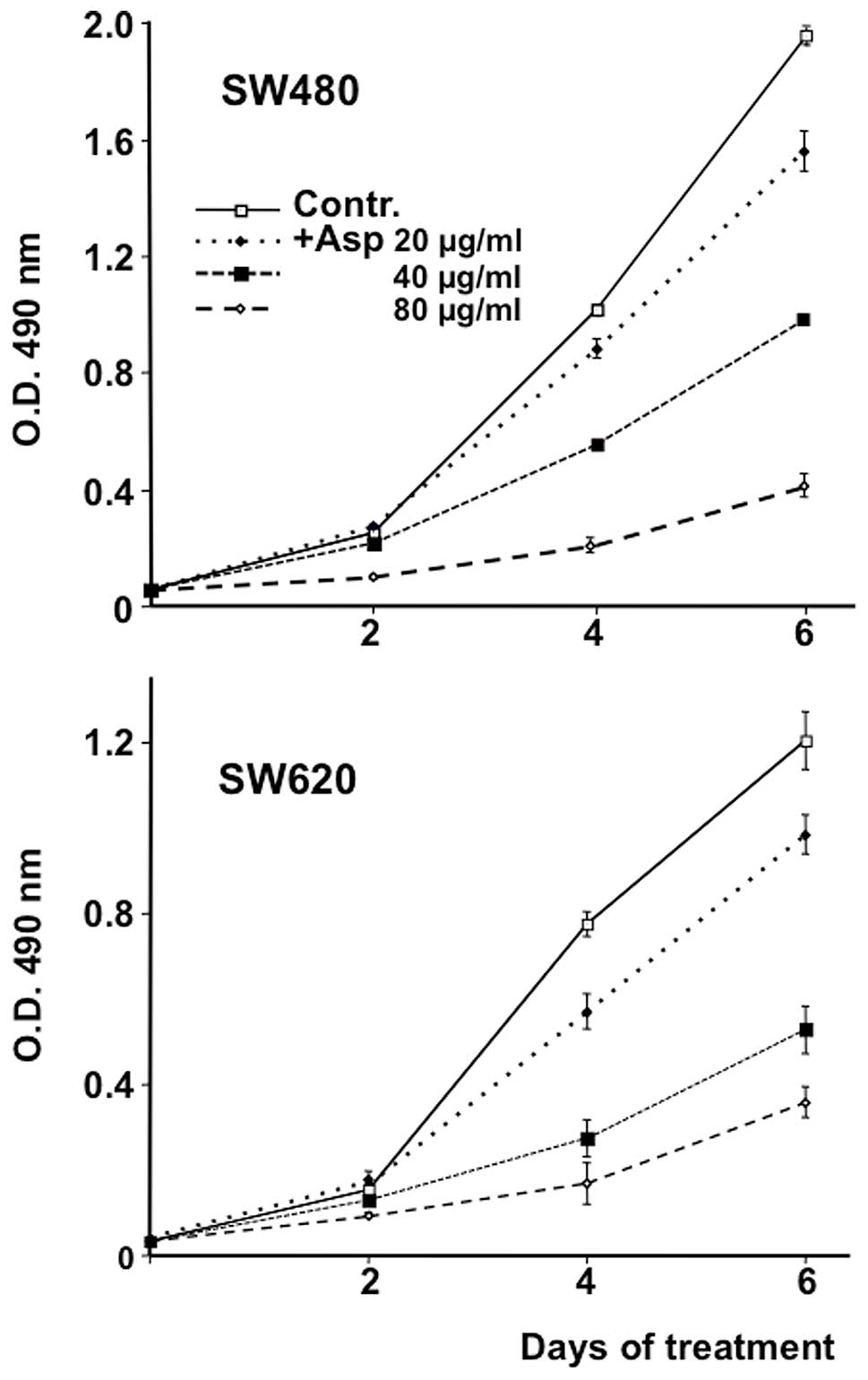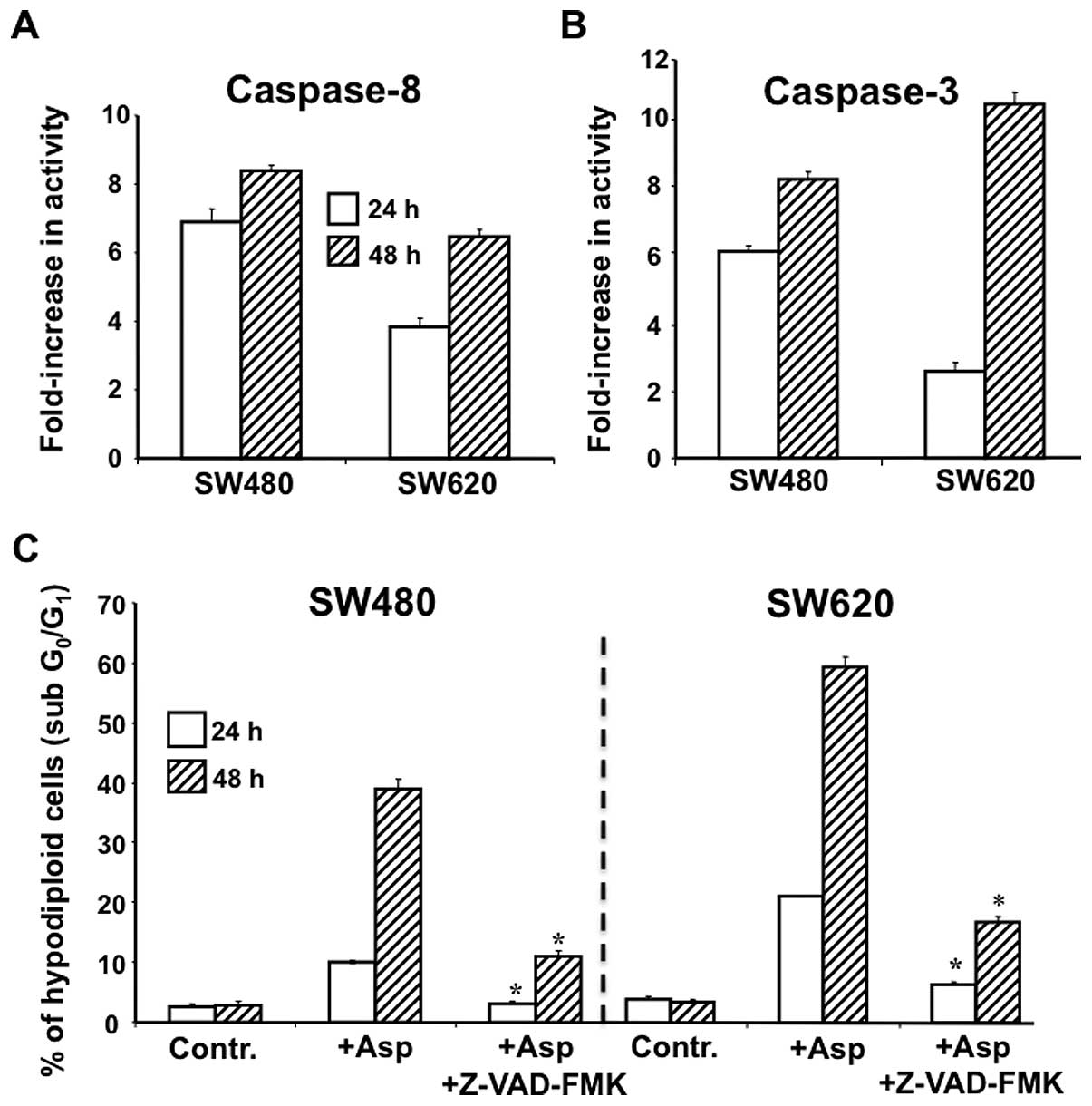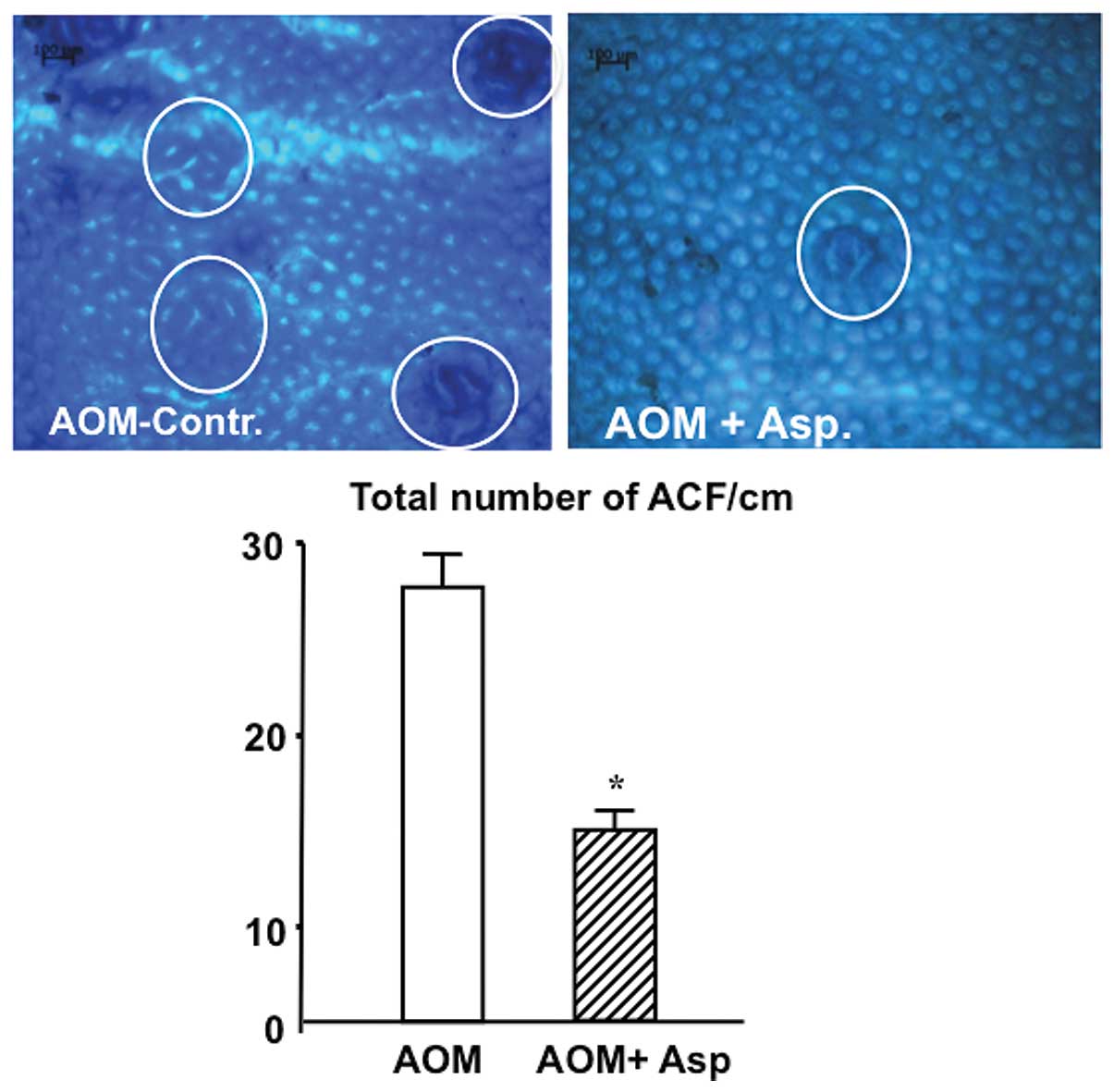|
1.
|
Kelloff GJ, Boone CW, Crowell JA, Steele
VE, Lubet R and Sigman CC: Chemopreventive drug development:
perspectives and progress. Cancer Epidemiol Biomarkers Prev.
3:85–98. 1994.PubMed/NCBI
|
|
2.
|
Kelloff GJ, Boone CW, Crowell JA, Steele
VE, Luber RA, Doody LA, Malone WF, Hawk ET and Sigman CC: New
agents for cancer chemoprevention. J Cell Biochem (Suppl). 26:1–28.
1996. View Article : Google Scholar
|
|
3.
|
Corpet DE and Taché S: Most effective
colon cancer chemo-preventive agents in rats: a systematic review
of aberrant crypt foci and tumor data, ranked by potency. Nutr
Cancer. 43:1–21. 2002. View Article : Google Scholar : PubMed/NCBI
|
|
4.
|
Tanaka T and Sugie S: Inhibition of colon
carcinogenesis by dietary non-nutritive compounds. J Toxicol
Pathol. 20:215–235. 2007. View Article : Google Scholar
|
|
5.
|
Kushi LH, Meyer KA and Jacobs DR Jr:
Cereals, legumes, and chronic disease risk reduction: evidence from
epidemiologic studies. Am J Clin Nutr. 70:451S–458S.
1999.PubMed/NCBI
|
|
6.
|
Bobe G, Barrett KG, Mentor-Marcel RA,
Saffiotti U, Young MR, Colburn NH, Albert PS, Bennink MR and Lanza
E: Dietary cooked navy beans and their fractions attenuate colon
carcinogenesis in azoxymethane-induced ob/ob mice. Nutr Cancer.
60:373–381. 2008. View Article : Google Scholar : PubMed/NCBI
|
|
7.
|
Steele VE, Pereira MA, Sigman CC and
Kelloff GJ: Cancer chemoprevention agent development strategies for
genistein. J Nutr. 125:713S–716S. 1995.PubMed/NCBI
|
|
8.
|
Yu S, Poobsasert O, Kennelly EJ, Chin CK,
Ho CT, Huang MT, Garrison SA and Cordell GA: Steroidal saponins
from Asparagus officinalis and their cytotoxic activity.
Planta Medica. 63:258–262. 1997.
|
|
9.
|
Huang X and Kong L: Steroidal saponins
from roots of Asparagus officinalis. Steroids. 71:171–176.
2006. View Article : Google Scholar : PubMed/NCBI
|
|
10.
|
Shao Y, Chin CK, Ho CT, Ma W, Garrison SA
and Huang MT: Anti-tumor activity of the crude saponins obtained
from asparagus. Cancer Lett. 104:31–36. 1996. View Article : Google Scholar : PubMed/NCBI
|
|
11.
|
Wang M, Tadmor Y, Wu QL, Chin CK, Garrison
SA and Simon JE: Quantification of protodioscin and rutin in
asparagus shoots by LC/MS and HPLC methods. J Agric Food Chem.
51:6132–6136. 2003. View Article : Google Scholar : PubMed/NCBI
|
|
12.
|
Makris DP and Rossiter JT: Domestic
processing of onion bulbs (Allium cepa) and asparagus spears
(Asparagus officinalis): effect on flavonol content and
antioxidant status. J Agric Food Chem. 49:3216–3222.
2001.PubMed/NCBI
|
|
13.
|
Villanueva-Suarez MJ, Redondo-Cuenca A,
Rodriguez-Sevilla MD and Heredia-Moreno A: Postharvest storage of
white asparagus (Asparagus officinalis I.): changes in
dietary fiber (Nonstarch polysaccharides). J Agric Food Chem.
47:3832–3836. 1999.PubMed/NCBI
|
|
14.
|
Yamamori A, Onodera S, Kikuchi M and
Shiomi N: Two novel oligosaccharides formed by
1F-fructosyltransferase purified from roots of asparagus
(Asparagus officinalis L.). Biosci Biotechnol Biochem.
66:1419–1422. 2002. View Article : Google Scholar : PubMed/NCBI
|
|
15.
|
Rodriguez R, Jaramillo S, Rodriguez G,
Espejo JA, Guillén R, Fernandez-Bolanos J, Heredia A and Jiménez A:
Antioxidant activity of ethanolic extracts from several asparagus
cultivars. J Agric Food Chem. 53:5212–5217. 2005. View Article : Google Scholar : PubMed/NCBI
|
|
16.
|
Jang DS, Cuendet M, Fong HH, Pezzuto JM
and Kinghorn AD: Constituents of Asparagus officinalis
evaluated for inhibitory activity against cyclooxygenase-2. J Agric
Food Chem. 52:2218–2222. 2004.PubMed/NCBI
|
|
17.
|
Mei HS, Wu YQMG and Wu ZY: The effects by
eating asparagus spears on blood-lipid levels of human body. Acta
Sci Nat Univ Pekin. 26:369–372. 1990.
|
|
18.
|
Wang H and Ng TB: Isolation of a novel
deoxyribonuclease with antifungal activity from Asparagus
officinalis seeds. Biochem Biophys Res Commun. 289:120–124.
2001. View Article : Google Scholar : PubMed/NCBI
|
|
19.
|
Huang J, Sun Y and Lu S: Experimental
study on apoptosis induced by ursolic acid isolated from asparagus
in HL-60 cells. Zhongguo Zhong Xi Yi Jie He Za Zhi. 19:296–298.
1999.(In Chinese).
|
|
20.
|
Liu W, Huang XF, Qi Q, Dai QS, Yang L, Nie
FF, Lu N, Gong DD, Kong LY and Guo QL: Asparanin A induces G(2)/M
cell cycle arrest and apoptosis in human hepatocellular carcinoma
HepG2 cells. Biochem Biophys Res Commun. 381:700–705. 2009.
View Article : Google Scholar : PubMed/NCBI
|
|
21.
|
Bhutani KK, Paul AT, Fayad W and Linder S:
Apoptosis inducing activity of steroidal constituents from
Solanum xanthocarpum and Asparagus racemosus.
Phytomedicine. 17:789–793. 2010. View Article : Google Scholar : PubMed/NCBI
|
|
22.
|
Hewitt RE, McMarlin A, Kleiner D, Wersto
R, Martin P, Tsokos M, Stamp GW and Stetler-Stevenson WG:
Validation of a model of colon cancer progression. J Pathol.
192:446–454. 2000. View Article : Google Scholar : PubMed/NCBI
|
|
23.
|
Reddy BS: Studies with azoxymethane-rat
preclinical model for assessing colon tumor development and
chemoprevention. Environ Mol Mutagen. 44:26–35. 2004. View Article : Google Scholar : PubMed/NCBI
|
|
24.
|
Corpet DE and Pierre F: How good are
rodent models of carcinogenesis in predicting efficacy in humans? A
systematic review and meta-analysis of colon cancer chemoprevention
in rats, mice and humans. Eur J Cancer. 41:1911–1922. 2005.
View Article : Google Scholar : PubMed/NCBI
|
|
25.
|
Bousserouel S, Gossé F, Bouhadjar M, Soler
L, Marescaux J and Raul F: Long-term administration of aspirin
inhibits tumour formation and triggers anti-neoplastic molecular
changes in a pre-clinical model of colon carcinogenesis. Oncol Rep.
23:511–517. 2010.
|
|
26.
|
Pereira MA, Barnes LH, Rassman VL, Kelloff
GV and Steele VE: Use of azoxymethane-induced foci of aberrant
crypts in rat colon to identify potential cancer chemopreventive
agents. Carcinogenesis. 15:1049–1054. 1994. View Article : Google Scholar
|
|
27.
|
Takayama T, Katsuki S, Takahashi Y, Ohi M,
Nojiri S, Sakamaki S, Kogawa K, Miyake H and Niitsu Y: Aberrant
crypt foci of the colon as precursors of adenoma and cancer. N Engl
J Med. 339:1277–1284. 1998. View Article : Google Scholar : PubMed/NCBI
|
|
28.
|
Bird RP and Good CK: The significance of
aberrant crypt foci in understanding the pathogenesis of colon
cancer. Toxicol Lett. 112–113:395–402. 2000.
|
|
29.
|
Livak KJ and Schmittgen TD: Analysis of
relative gene expression data using real-time quantitative PCR and
the 2(−Delta Delta C(T)) method. Methods. 25:402–408. 2001.
|
|
30.
|
Riccardi C and Nicoletti I: Analysis of
apoptosis by propidium iodide staining and flow cytometry. Nat
Protoc. 1:1458–1461. 2006. View Article : Google Scholar : PubMed/NCBI
|
|
31.
|
Reed JC: Mechanisms of apoptosis. Am J
Pathol. 157:1415–1430. 2000. View Article : Google Scholar
|
|
32.
|
Jin Z, McDonald ER III, Dicker DT and
El-Deiry WS: Deficient tumor necrosis factor-related
apoptosis-inducing ligand (TRAIL) death receptor transport to the
cell surface in human colon cancer cells selected for resistance to
TRAIL-induced apoptosis. J Biol Chem. 279:35829–35839. 2004.
View Article : Google Scholar
|
|
33.
|
Cawston TE and Wilson AJ: Understanding
the role of tissue degrading enzymes and their inhibitors in
development and disease. Best Pract Res Clin Rheumatol.
20:983–1002. 2006. View Article : Google Scholar : PubMed/NCBI
|
|
34.
|
Spinale FG: Myocardial matrix remodeling
and the matrix metalloproteinases: Influence on cardiac form and
function. Physiol Rev. 87:1285–1342. 2007. View Article : Google Scholar : PubMed/NCBI
|
|
35.
|
Gunter MJ, Canzian F, Landi S, Chanock SJ,
Sinha R and Rothman N: Inflammation-related gene polymorphisms and
colorectal adenoma. Cancer Epidemiol Biomarkers Prev. 15:1126–1131.
2006. View Article : Google Scholar : PubMed/NCBI
|
|
36.
|
Buck I, Morceau F, Grigorakaki C, Dicato M
and Diederich M: Linking anemia to inflammation and cancer: the
crucial role of TNFalpha. Biochem Pharmacol. 77:1572–1579. 2009.
View Article : Google Scholar : PubMed/NCBI
|
|
37.
|
Ramasundara M, Leach ST, Lemberg DA and
Day AS: Defensins and inflammation: the role of defensins in
inflammatory bowel disease. J Gastroenterol Hepatol. 24:202–208.
2009. View Article : Google Scholar : PubMed/NCBI
|
|
38.
|
Reed JC: Dysregulation of apoptosis in
cancer. J Clin Oncol. 17:2941–2953. 1999.PubMed/NCBI
|
|
39.
|
Wang S: TRAIL: a sword for killing tumors.
Curr Med Chem. 17:3309–3317. 2010. View Article : Google Scholar : PubMed/NCBI
|
|
40.
|
Bellail AC, Qi L, Mulligan P, Chhabra V
and Hao C: TRAIL agonists on clinical trials for cancer therapy:
the promises and the challenges. Rev Recent Clin Trials. 4:34–41.
2009. View Article : Google Scholar : PubMed/NCBI
|
|
41.
|
Thorburn A, Behbakht K and Ford H: Trail
receptor-targeted therapeutics: resistance mechanisms and
strategies to avoid them. Drug Resist Updat. 11:17–24. 2008.
View Article : Google Scholar : PubMed/NCBI
|
|
42.
|
Wang H, Khor TO, Shu L, Su Z, Fuentes F,
Lee JH and Kong AN: Plants vs. cancer: a review on natural
phytochemicals in preventing and treating cancers and their drug
ability. Anticancer Agents Med Chem. 12:1281–1305. 2012. View Article : Google Scholar : PubMed/NCBI
|
|
43.
|
Kong CK, Lam WS, Chiu LC, Ooi VE, Sun SS
and Wong YS: A rice bran polyphenol, cycloartenyl ferulate, elicits
apoptosis in human colorectal adenocarcinoma SW480 and sensitizes
metastatic SW620 cells to TRAIL-induced apoptosis. Biochem
Pharmacol. 77:1487–1496. 2009. View Article : Google Scholar
|
|
44.
|
Kauntz H, Bousserouel S, Gossé F and Raul
F: The flavonolignan silibinin potentiates TRAIL-induced apoptosis
in human colon adenocarcinoma and in derived TRAIL-resistant
metastatic cells. Apoptosis. 17:797–809. 2012. View Article : Google Scholar
|
|
45.
|
Lu H, Ouyang W and Huang C: Inflammation,
a key event in cancer development. Mol Cancer Res. 4:221–233. 2006.
View Article : Google Scholar : PubMed/NCBI
|
|
46.
|
Fingleton B, Vargo-Gogola T, Crawford HC
and Matrisian LM: Matrilysin (MMP-7) expression selects for cells
with reduced sensitivity to apoptosis. Neoplasia. 3:459–468. 2001.
View Article : Google Scholar : PubMed/NCBI
|
|
47.
|
Nyormoi O, Mills L and Bar-Eli M: An
MMP-2/MMP-9 inhibitor, 5a, enhances apoptosis induced by ligands of
the TNF receptor superfamily in cancer cells. Cell Death Differ.
10:558–569. 2003. View Article : Google Scholar : PubMed/NCBI
|
|
48.
|
Friedl P and Wolf K: Tumor-cell invasion
and migration: Diversity and escape mechanisms. Nat Rev Cancer.
3:362–374. 2003. View Article : Google Scholar : PubMed/NCBI
|
|
49.
|
Johansson N, Ahonen M and Kähäri VM:
Matrix metalloproteinases in tumor invasion. Cell Mol Life Sci.
57:5–15. 2000. View Article : Google Scholar
|
|
50.
|
Rajput ZI, Hu SH, Xiao CW and Arijo AG:
Adjuvant effects of saponins on animal immune responses. J Zhejiang
Univ Sci B. 8:153–161. 2007. View Article : Google Scholar : PubMed/NCBI
|
|
51.
|
Sabater-Molina M, Larqué E, Torrella F and
Zamora S: Dietary fructooligosaccharides and potential benefits on
health. J Physiol Biochem. 65:215–328. 2009. View Article : Google Scholar
|
|
52.
|
Chien MH, Ying TH, Yang SF, Yu JK, Hsu CW,
Hsieh SC and Hsieh YH: Lipocalin-2 induces apoptosis in human
hepatocellular carcinoma cells through activation of mitochondria
pathways. Cell Biochem Biophys. 64:177–186. 2012. View Article : Google Scholar : PubMed/NCBI
|
|
53.
|
Papo N and Shai Y: Host defense peptides
as new weapons in cancer treatment. Cell Mol Life Sci. 62:784–790.
2005. View Article : Google Scholar : PubMed/NCBI
|
|
54.
|
Lee HJ, Lee EK, Lee KJ, Hong SW, Yoon Y
and Kim JS: Ectopic expression of neutrophil gelatinase-associated
lipocalin suppresses the invasion and liver metastasis of colon
cancer cells. Int J Cancer. 118:2490–2497. 2006. View Article : Google Scholar
|
|
55.
|
Simms LA, Doecke JD, Walsh MD, Huang N,
Fowler EV and Radford-Smith GL: Reduced alpha-defensin expression
is associated with inflammation and not NOD2 mutation status in
ileal Crohn’s disease. Gut. 57:903–910. 2008.
|
|
56.
|
Friedl A, Stoesz SP, Buckley P and Gould
MN: Neutrophil gelatinase-associated lipocalin in normal and
neoplastic human tissues. Cell type-specific pattern of expression.
Histochem J. 31:433–441. 1999. View Article : Google Scholar : PubMed/NCBI
|
|
57.
|
Shi J, Aono S, Lu W, Ouellette AJ, Hu X,
Ji Y, Wang L, Lenz S, van Ginkel FW, Liles M, Dykstra C, Morrison
EE and Elson CO: A novel role for defensins in intestinal
homeostasis: regulation of IL-1beta secretion. J Immunol.
179:1245–1253. 2007. View Article : Google Scholar : PubMed/NCBI
|


















